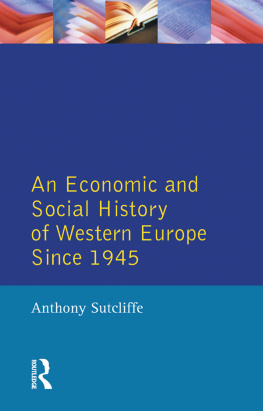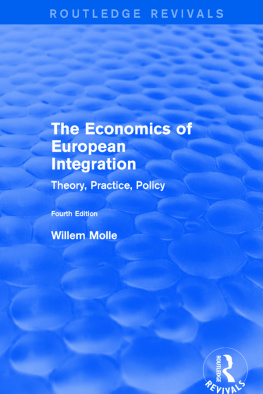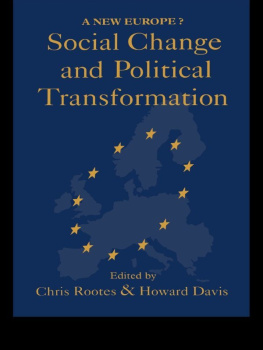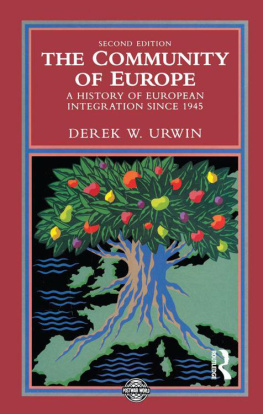ROUTLEDGE LIBRARY EDITIONS: ECONOMIC GEOGRAPHY
Volume 11
THE WESTERN EUROPEAN ECONOMY
THE WESTERN EUROPEAN ECONOMY
A geography of post-war development
ALLAN M. WILLIAMS
First published in 1987
This edition first published in 2015
by Routledge
2 Park Square, Milton Park, Abingdon, Oxon OX14 4RN
by Routledge
711 Third Avenue, New York, NY 10017
Routledge is an imprint of the Taylor & Francis Group, an informa business
1987 Allan Williams
All rights reserved. No part of this book may be reprinted or reproduced or utilised in any form or by any electronic, mechanical, or other means, now known or hereafter invented, including photocopying and recording, or in any information storage or retrieval system, without permission in writing from the publishers.
Trademark notice: Product or corporate names may be trademarks or registered trademarks, and are used only for identification and explanation without intent to infringe.
British Library Cataloguing in Publication Data
A catalogue record for this book is available from the British Library
ISBN: 978-1-138-85764-3 (Set)
eISBN: 978-1-315-71580-3 (Set)
ISBN: 978-1-138-85959-3 (Volume 11)
eISBN: 978-1-315-71709-8 (Volume 11)
Publishers Note
The publisher has gone to great lengths to ensure the quality of this reprint but points out that some imperfections in the original copies may be apparent.
Disclaimer
The publisher has made every effort to trace copyright holders and would welcome correspondence from those they have been unable to trace.
The Western European Economy
A geography of post-war development
Allan M. Williams
HUTCHINSON
LondonMelbourneAucklandJohannesburg
BARNES & NOBLE BOOKS
Totowa, New Jersey
Hutchinson Education
An imprint of Century Hutchinson Ltd
6265 Chandos Place, London WC2N 4NW
Century Hutchinson Australia Pty Ltd
PO Box 496, 1622 Church Street, Hawthorn,
Victoria 3122, Australia
Century Hutchinson New Zealand Ltd
PO Box 40086, Glenfield, Auckland 10,
New Zealand
Century Hutchinson South Africa (Pty) Ltd
PO Box 337, Berglvei 2012, South Africa
First published 1987
First published in the USA 1987 by
BARNES & NOBLE BOOKS
81 ADAMS DRIVE
TOTOWA, NEW JERSEY, 07512
Allan Williams 1987
Set in Linotron Times
by Hope Services, Abingdon
Printed and bound in Great Britain by
Mackays of Chatham
British Library Cataloguing in Publication Data
Williams, Allan M.
The Western European economy: a geography
of post-war development.
1. EuropeEconomic conditions
2. 1945
I. Title
330.94055 HC240
ISBN: (UK) 0 09 173161 5
ISBN: (US) 0 389 20772 1
Contents
The need to study and understand changes in the western European economy has never been greater than is the case in the late 1980s. More than forty years after the end of the Second World War, Europe has experienced a remarkable economic expansion followed, since the mid-1970s, by sharp recession. In this time the role of the region has been transformed in its relationship with the USA, Japan, the Eastern block and the newly industrializing countries (NICs) of Africa, Latin America and, especially, Asia. There have also been changes within Europe both in terms of the balance of economic strength between the North and the Mediterranean, and amongst individual states. Not least, it seems that the pace and magnitude of events have forced European affairs upon our attention in new and more urgent ways.
The European Community (EC), in the course of little more than a decade, has expanded from the original club of six to the present twelve members, including more than two-thirds of the major states in western Europe. This has increased the role of international economic policy making, relative to the power of individual states. However, the EC has proven incapable of internal reorganization to meet the growing need to reform its economic policies; at present these dominate agriculture, overshadow manufacturing and ignore service activities. Enlargement of the EC has, however, confirmed the changing structure of the European economy. With the accession of Greece in 1981, and of Spain and Portugal in 1986, the centre of economic power can hardly be said to have shifted to the Mediterranean, but this region has experienced some of the more profound economic changes of the last four decades. Yet, only recently have we begun to appreciate, say, the extent of commercialization of Spanish agriculture or the strength of Italian manufactured exports. Meanwhile, beyond the EC, the Scandinavian and Alpine states continue to provide examples of alternative models of economic and social development.
In the shorter run, however certainly since the early 1970s the economic outlook for Mediterranean and Scandinavian Europe, in common with most other capitalist regions, has dimmed considerably with the onset of global economic crisis. The symptoms of the crisis can be seen in many different forms, ranging from Britains inner city riots, to the inability of some Portuguese firms to pay any wages for more than twelve months, to the bankruptcy of Swedens Kockum, Europes largest shipyard. It is not surprising, therefore, that the search for solutions to high unemployment and stagnant growth has become increasingly international as the laggards, such as the UK or Belgium, have sought to learn from the experiences of more successful economies, such as the Federal Republic of Germany or the Netherlands. For these reasons, it has become more important to re-examine the sources, forms and consequences of economic development in western Europe at large, in individual states and in particular regions.
Reassessment of the European experience is also pressing because of the need for empirical analyses to catch up with new theoretical perspectives. Economic geography increasingly has become politico-economic geography, incorporating analyses of state policies, social classes and internationalization tendencies alongside more traditional concerns such as firm formation, company organization, and regional policies. There has been some lowering of traditional disciplinary boundaries and a shift to a more holistic viewpoint, whereby the theories of a more integrated (and largely critical) social science are brought to bear on particular features of development. A number of examples of such approaches to economic geography exist, and they are well-illustrated by the writings of Massey (1978 and 1984 provide useful benchmarks in the development of her work).* In short, there is a need to review the changing economic geography of post-war Europe in a new light, whereby study of patterns (of firms, coal mines, etc.) is replaced by analysis of the processes which produce these that is, capital accumulation and the tensions between capital, labour and the state. These categories have to be viewed as anything but homogeneous, for they are organized differently at the international and the interregional levels and the relationships between them change over time. Capital assumes many forms ownership may be indigenous or multinational, private or public and each has its own imperatives, potential mobility and forms of organization. Labour, too, is variable and can be disaggregated by age, sex, geographical origin, level of collective organization, and militancy. Similarly, the state represents a multitude of interests and has to fulfil a number of functions. This may give rise to conflicts both between states, and between central and local government, not to mention international bodies, such as the EC or the General Agreement on Trade and Tariffs.








